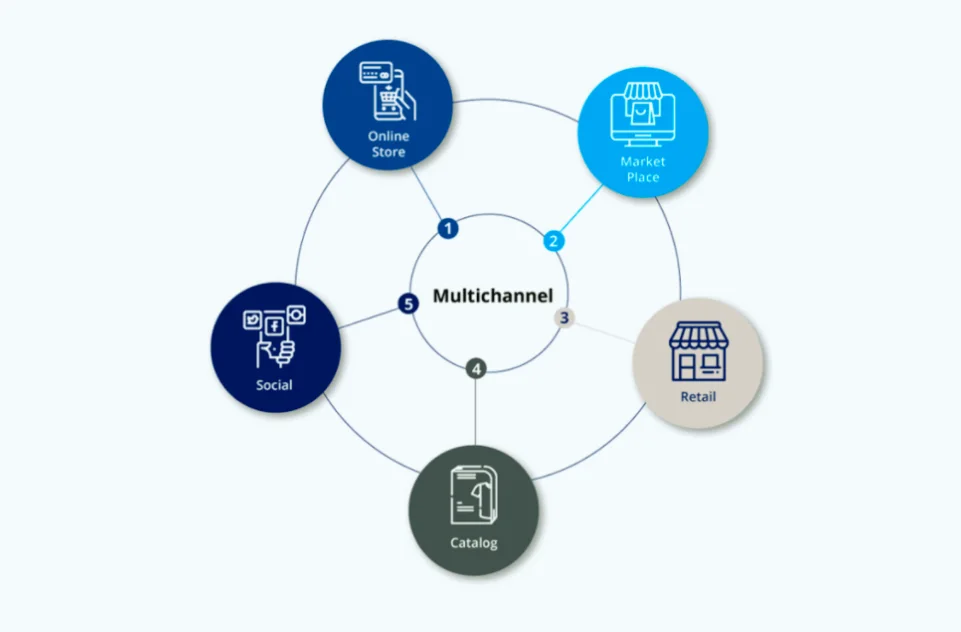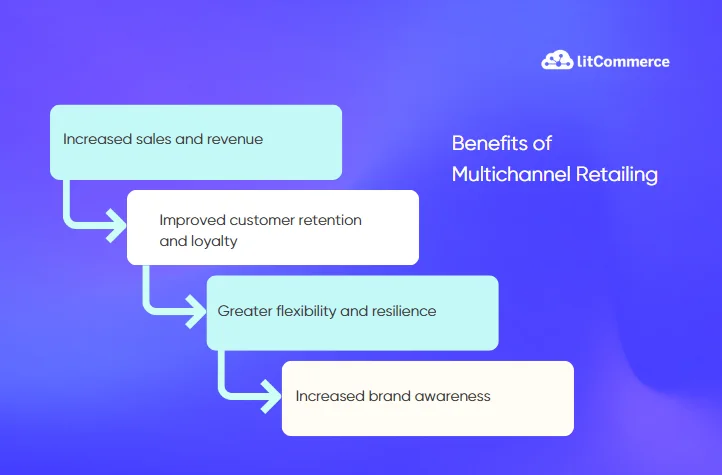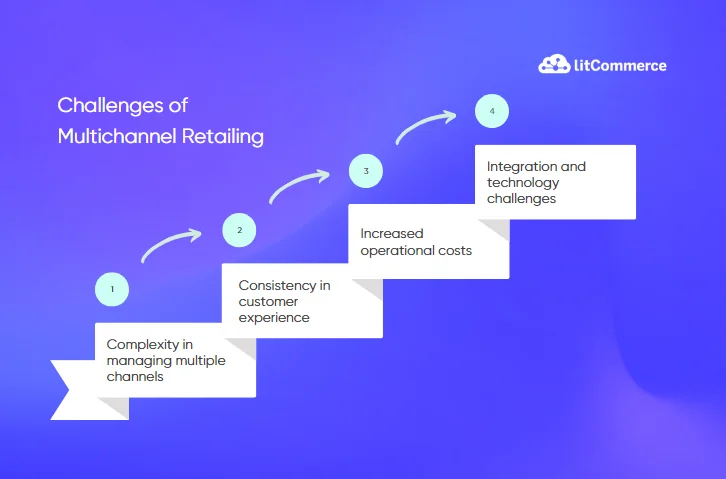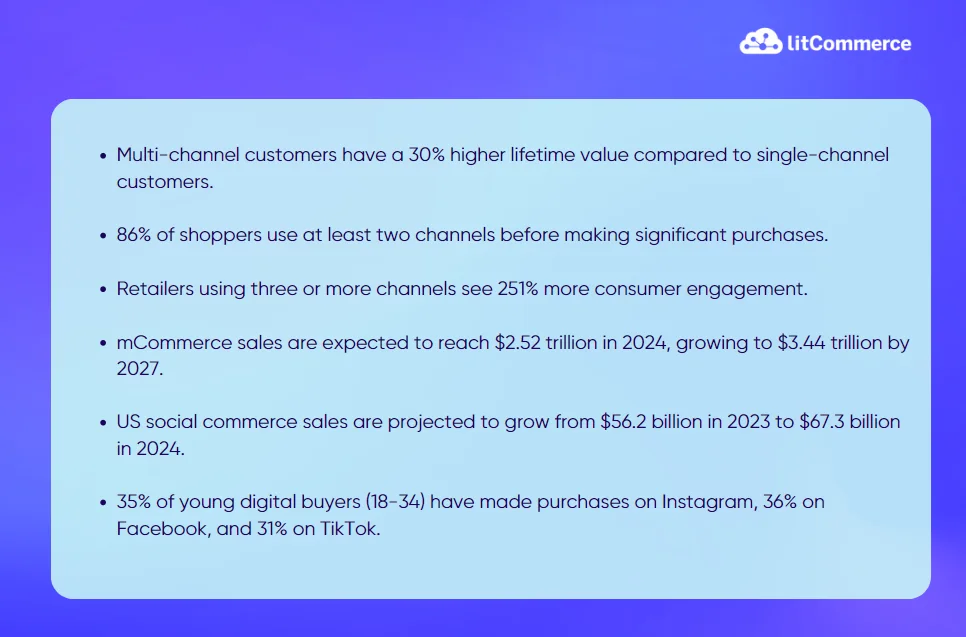Multichannel retailing is a marketing strategy where a business offers various sales channels, such as physical stores, online platforms, eCommerce websites, mobile apps, and social media, to sell its products or services.
The goal of multichannel retailing is to connect with more people by selling products in the places they like to shop. This helps boost sales and makes shopping a better experience for customers.
Nike is the best example of a multichannel retailing definition. Nike retails and markets its shoes and apparel through Nike store outlets, its online store, and its mobile app. Furthermore, Nike products are offered in different department stores, internet stores, and some specialized sportswear stores. Thus, by using all these multiple channels, Nike ensures that its products are distributed effectively through physical stores, online, and mobile devices.
Key takeaways:
- Multichannel retailing expands reach by offering customers diverse shopping channels, enhancing sales opportunities and customer satisfaction.
- eCommerce websites and online marketplaces are pivotal in multichannel retailing, offering brand control and increased visibility.
- A successful multichannel strategy demands consistent branding, integrated inventory management, and smart channel selection to meet customer needs.
- Multichannel retailing offers multiple touchpoints, omnichannel goes further by integrating these channels and utilizing data to enhance customer engagement and loyalty.
Types of Multichannel Retailing Channels
With the multichannel retailing definition in mind, it’s time to explore the different types of channels.

Physical stores remain important in retail because they let customers see and touch products before buying. While online shopping is growing, these stores are vital for multichannel retail, especially for brands that value face-to-face connections with customers.
eCommerce websites are vital in multichannel retailing, allowing companies full control over their brand, direct sales, and valuable customer insights to build brand loyalty.
Meanwhile, online marketplaces like Amazon, eBay, and Etsy allow businesses to showcase their products alongside other sellers, which helps them reach more customers. These platforms are especially helpful for small businesses that want to get noticed and boost sales without the extra costs of having their own website.
Social media platforms currently refer to strong sales channels because they let businesses sell directly on sites like Facebook, Instagram, and Pinterest.
Although catalogs and direct mail might seem old-fashioned, they can still effectively reach specific groups and promote targeted offers. Likewise, pop-up stores generate excitement by providing temporary retail spaces for businesses to try new markets or display seasonal products.
In B2B, wholesale and distribution let companies sell products in bulk to retailers or distributors, helping them reach more customers and create steady income.
Finally, vending machines and automated kiosks give consumers easy, self-service access to products in busy areas, available 24/7.
Learn how multichannel distribution strategies complement different types of multichannel retailing to enhance your overall sales performance.
Benefits of Multichannel Retailing for Businesses?
Multichannel retailing provides businesses with a wealth of opportunities, from expanding customer reach to driving sales growth and fostering brand loyalty. Let’s take a closer look at the key advantages of this approach:

Increased sales and revenue
One of the most significant advantages of multichannel retailing is the potential for increased sales. A Harvard Business Review study shows that 73% of customers shop using multiple channels.
Moreover, customers exposed to multi-channel marketing campaigns spend about 10% more than those who aren’t (Stated by Embryo). This site also shows that companies that provide a consistent experience across all channels see a 23x higher customer satisfaction rate.
Improved customer retention and loyalty
Companies with strong omnichannel customer engagement retain, on average, 89% of their customers, considerably higher than the 33% average customer retention rate (according to Embryo). Meanwhile, other research shows that multi-channel customers have a 30% higher lifetime value than single-channel customers, indicating greater long-term profitability for the business.
Greater flexibility and resilience
Multichannel retailing allows businesses to adapt to market changes and consumer preferences. For example, during the COVID-19 pandemic, companies with strong online and offline presences were better equipped to continue operations despite disruptions to physical stores.
A study by eMarketer showed that online sales in the U.S. grew by 32.4% in 2020 as consumers increasingly turned to digital channels for shopping. This adaptability allows businesses to remain resilient in the face of unforeseen challenges.
Increased brand awareness
Being present on multiple platforms increases a brand’s visibility, making it more recognizable to a broader audience. A report by Google indicates that 90% of consumers switch between devices to accomplish a goal, such as making a purchase, highlighting the importance of a multichannel presence.
For a deeper understanding of multichannel eCommerce, including its definition and key practices, check out our comprehensive guide here.
Challenges When Going Multichannel Retailing
While multichannel retailing offers numerous benefits, it also presents several challenges that businesses must navigate to succeed, such as:

Complexity in managing multiple channels
One of the biggest challenges in multichannel retailing is the complexity of managing various sales channels simultaneously. Coordinating inventory, pricing, and promotions across different platforms can be daunting. Salesforce reported that 43% of retailers identify inventory visibility as their biggest pain point when managing multiple channels.
Furthermore, Inefficient inventory management can lead to stockouts (losing 4% of sales) or overstocking (tying up capital in slow-moving inventory).
Consistency in customer experience
Building a consistent customer experience across all channels is important but challenging. Customers want smooth interactions whether they are shopping online, in-store, or using a mobile app. A Salesforce report report found that 75% of consumers expect consistent experiences across different channels, but only 28% of B2C companies can serve customers on every channel. Inconsistent experiences can result in customer dissatisfaction and lost sales.
Increased operational costs
Expanding into multiple channels often requires significant technological, staffing, and logistics investment. According to McKinsey, companies that engage in multichannel retailing may face 20-30% higher operational costs compared to single-channel retailers. These costs arise from maintaining multiple inventory systems, managing different fulfillment processes, and investing in technology that integrates all channels. Without careful cost management, these expenses can eat into profit margins.
Integration and technology challenges
Collecting and integrating data from various channels can be a significant challenge in multichannel retailing. Businesses need to combine data from online sales, physical stores, social media, and other platforms to gain a holistic view of customer behavior. However, a study by Aberdeen Group found that 70% of companies struggle with integrating customer data across different channels, leading to fragmented insights and ineffective marketing strategies.
Don’t be afraid of any challenges when going multichannel
LitCommerce effectively addresses and simplifies the challenges sellers face when managing sales across multiple channels, making multichannel retailing much easier.
Look at Some Notable Statistics in Multichannel Retailing

Multichannel retailing has seen significant growth in recent years, driven by changing consumer behavior and technological advancements. Here are some notable statistics that highlight the growth in user behavior for multichannel retail from 2023-2024, along with predictions for 2025:
- Customer engagement and value: The analysis indicated that multi-channel customers have 30% higher lifetime value as compared to those who use one channel. This figure shows that multichannel is a crucial aspect for retail businesses that want to increase customers’ loyalty and, as a result, increase overall sales.
- Engagement in multichannel shoppers: The number of consumers engaging in multichannel shopping has risen sharply. 86% of shoppers regularly switch between at least two marketing channels before making significant purchases, showcasing the importance of a cohesive multichannel strategy for retailers. Furthermore, retailers using three or more channels experience 251% more consumer engagement compared to those using a single channel
- Growth in mobile commerce (mCommerce): mCommerce is growing rapidly, with sales expected to reach $2.52 trillion in 2024, a 16.3% increase from $2.16 trillion in 2023. The trend is set to continue, with total sales expected to reach $3.44 trillion by 2027.
- Social commerce surge: The role of social media in retail is expanding rapidly. In the U.S., social commerce sales are expected to grow from $56.2 billion in 2023 to $67.3 billion in 2024, indicating a steady increase in consumer spending through social platforms. Moreover, approximately 35% of digital buyers aged 18 to 34 have purchased on Instagram, while 36% have done so on Facebook and 31% on TikTok.
This amazing statistic shows the power of multichannel distribution—learn how to use it effectively with our multichannel selling guide.
How to Craft an Effective Multichannel Retailing?
Understand your target audience

A key requirement for successful multichannel retailing is understanding your customers. It’s important to gather information about their preferences, activities, and shopping behaviors across different channels. Tools like Google Analytics, social media insights, and direct customer feedback can help with this. By doing so, you can learn how to effectively engage with customers as well as encourage them to shop at your stores.
Choose the right channels
Selecting the appropriate channels is critical for the success of your multichannel retailing strategy. Identify the channels that align with your brand and resonate with your audience. Common channels include brick-and-mortar stores, eCommerce websites, online marketplaces (like Amazon or eBay), social media platforms, mobile apps, and direct mail.
For example, if your target audience consists of younger consumers, prioritizing mobile commerce and social media platforms like Instagram or TikTok may be more effective.
Ensure a consistent brand experience

Consistency across all channels is key to successful multichannel retailing. Your brand’s message, tone, and visual identity should be uniform whether customers are interacting with you online or in a physical store. This means using the same logos, color schemes, and messaging across all platforms. For instance, if you’re running a promotion, ensure it is advertised similarly across your eCommerce site, social media platforms, and physical locations.
Integrate your inventory
Integrated systems ensure that your inventory levels are accurate and up-to-date across all channels, preventing stockouts and overstocking.
LitCommerce is an excellent tool to facilitate this integration. It allows you to synchronize inventory, orders, and product listings across your eCommerce website, online marketplaces like Amazon, eBay, and Etsy, and other sales channels. With LitCommerce, you can manage everything from a single dashboard, saving time as well as reducing the risk of errors.

Invest in marketing automation
Marketing automation tools can simplify your multichannel marketing efforts. They help you manage and automate campaigns across different channels, making sure your message gets to the right audience at the right time.
Take an example: you may set up automated email campaigns, schedule social media posts, and run retargeting ads based on how customers behave across various channels.
Multichannel selling made easy with LitCommerce
LitCommerce helps businesses create a seamless multichannel selling experience. Hence, you can focus on providing top-notch customer service to your buyers, hitting two targets with one shot.
What’s the Difference Between Omnichannel vs Multichannel in Retail?
Feature | Omnichannel retailing | Multichannel retailing |
Focus | • Seamless customer experience | • Multiple sales channels |
Integration | • High | • Limited |
Experience | • Consistent, personalized | • May vary |
Data | • Leveraged for personalization | • Siloed |
Messaging | • Unified | • May vary |
Engagement | • Deeper, personalized | • Transactional |
Goal | • Customer satisfaction & loyalty | • Convenience & choice |
Both omnichannel and multichannel retailing involve selling products or services through various channels, but they have different approaches and focuses.
Multichannel retailing primarily focuses on providing customers with various touchpoints to interact with a brand and make purchases. It offers multiple channels, like physical stores, online stores, mobile apps, etc., allowing customers to choose their preferred shopping method. However, these channels often operate independently, with limited integration and data sharing. This can result in fragmented customer experiences and inconsistent brand messaging.
Omnichannel retailing, on the other hand, takes a more unified approach, focusing on creating a smooth and integrated customer experience across all channels. It emphasizes connectivity and data sharing to ensure a consistent brand experience, regardless of the customer’s channel. For example, customers might browse products on their mobile app, add items to their cart, and then complete the purchase on their desktop computer, with their cart information automatically transferred.
Multichannel Retailing – FAQs
Apple is a strong example of multichannel selling. They connect their physical retail stores, online store, mobile app, and authorized resellers to reach customers through various channels. In this way, Apple can offer consistent product availability and customer support, enhancing the overall shopping experience across different platforms. Multichannel retail is the practice where a business sells products through various independent outlets, for instance, internet shops, main street stores, and popup stores, and more. However, omnichannel retail integrates these channels and gives buyer a consistent and connected shopping experience across the various channels that can easily switch back and forth during the shopping process. Indeed, Walmart is a multi-channel retailer company. They operate and sell products through physical stores, online website, mobile application as well as through an online marketplace.
Conclusion
Multichannel retailing is not just about expanding your presence; it’s about creating meaningful connections across every platform. So, ask yourself—are you ready to meet your customers on their terms and lead them on a seamless journey through your brand? Today, multichannel retailing is the standard, and retailers who haven’t adopted it must do so quickly.
If you want to stand out in the eCommerce space, then the LitCommerce blog should be your source. But if you’re looking particularly at fast and effective selling across multiple platforms, then LitCommerce is the best option. If you have any questions or need help, please do not hesitate to give us a call!




